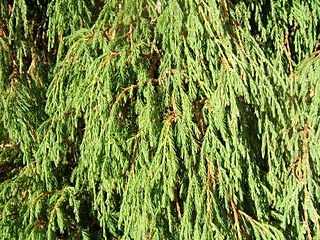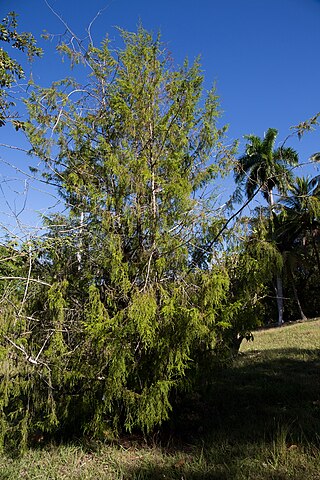
The black-capped petrel, also known as the diablotín, is a small seabird native to the West Indies in the genus Pterodroma. It is a long-winged petrel with a grey-brown back and wings, with a white nape and rump. Underparts are mainly white apart from a black cap and some dark underwing markings. It picks food items such as squid from the ocean surface.

Juniperus communis, the common juniper, is a species of small tree or shrub in the cypress family Cupressaceae. An evergreen conifer, it has the largest geographical range of any woody plant, with a circumpolar distribution throughout the cool temperate Northern Hemisphere.

Pic la Selle, also called Morne La Selle, is the highest peak in Haiti at 2,680 metres (8,793 ft) above sea level. The mountain is part of the Chaîne de la Selle mountain range. It is located in the Ouest administrative department.

The Hispaniolan pine forests are a subtropical coniferous forest ecoregion found on the Caribbean island of Hispaniola, which is shared by Haiti and the Dominican Republic. The ecoregion covers 11,600 km2 (4,500 sq mi), or about 15% of the island. It lies at elevations greater than 800 m (2,600 ft) in the mountains of Hispaniola, extending from the Cordillera Central of the Dominican Republic and into the Massif du Nord of Haiti. It is surrounded at lower elevations by the Hispaniolan moist forests and Hispaniolan dry forests ecoregions, which cover the remainder of the island. Annual rainfall is 1,000–2,000 mm (39–79 in).

Juniperus sabina, the savin juniper or savin, is a species of juniper native to the mountains of central and southern Europe and western and central Asia, from Spain to eastern Siberia, typically growing at altitudes of 1,000–3,300 metres.

Juniperus thurifera is a species of juniper native to the mountains of the western Mediterranean region, from southern France across eastern and central Spain to Morocco and locally in northern Algeria.

Juniperus recurva, commonly named the Himalayan juniper or drooping juniper, is a juniper native to the Himalaya, from northern Pakistan, through India, Nepal and Bhutan, to western Yunnan in southwestern China. It grows at altitudes of 3,000–4,000 metres.

Juniperus squamata, the flaky juniper, or Himalayan juniper is a species of coniferous shrub in the cypress family Cupressaceae, native to the Himalayas and China.

Juniperus deppeana is a small to medium-sized tree reaching 10–15 metres in height. It is native to central and northern Mexico and the southwestern United States.

Juniperus flaccida is a large shrub or small tree reaching 5–10 metres tall. It is native to central and northern Mexico and the extreme southwest of Texas, United States. It grows at moderate altitudes of 800–2,600 metres, on dry soils.

Juniperus phoenicea, the Phoenicean juniper or Arâr, is a juniper found throughout the Mediterranean region.
Morne du Cibao is the third highest mountain in Haiti, after Pic la Selle and Pic Macaya. It is the highest point in the Montagnes du Cibao, and rises to an elevation of 2,280 metres (7,480 ft) above sea level.
Juniperus barbadensis, also known as West Indian juniper, is a species of conifer in the family Cupressaceae endemic to the West Indies.

Juniperus saxicola is a species of conifer in the family Cupressaceae. It is found only in Cuba.

Juniperus semiglobosa, the Himalayan pencil juniper, is a species of juniper native to the mountains of Central Asia, in northeastern Afghanistan, westernmost China (Xinjiang), northern Pakistan, southeastern Kazakhstan, Kyrgyzstan, western Nepal, northern India, Tajikistan, and Uzbekistan. It grows at altitudes of 1,550–4,420 metres.

The southern pastel frog or Hispaniola robber frog is a species of frog in the family Eleutherodactylidae. It is endemic to Hispaniola and known from the Massif de la Selle, both in the Dominican Republic and in Haiti. Its natural habitats are upland pine forests. Males call from the ground. It is threatened by habitat loss caused by logging and agriculture. It is known from the Sierra de Bahoruco National Park, but habitat degradation is occurring in this area too.

The La Selle thrush is a species of bird in the family Turdidae endemic to the Caribbean island of Hispaniola. A skulker of broadleaf and pine forests around 1300m, it is limited to a small and declining population in the inland Dominican Republic, as well as a relict population in Haiti.

The Hispaniolan trogon is a species of bird in the family Trogonidae. It is endemic to Hispaniola in the Caribbean. It is one of the only two trogon species found in the Caribbean. It is the national bird of Haiti.

The wildlife of Haiti is important to the country because of its biodiversity. According to the World Conservation Monitoring Centre, Haiti is considered to be "one of the most biologically significant countries of the West Indies". With an estimated 5,600 plant species on the island of Hispaniola, some of which only occur in Haiti, 36% are considered as endemic to the island. A mountainous area country, it is situated in the western three-eighths of Hispaniola and shares a border with the Dominican Republic. There are nine life zones, from low desert to high cloud forests, as well as four mountain ranges, and hundreds of rivers and streams and the coral reefs in the seas that surround the islands. Issues of environmental damage, expanding population, deforesting and erosion are of concern; less than 2% of the original forest remains on account of deforestation. This degradation is traced from the 17th century to 19th century starting with the French colonization of the Haiti and population explosion during the 20th century and for the purpose of forestry and sugar-related industries, degraded the forests. and the environment.


















